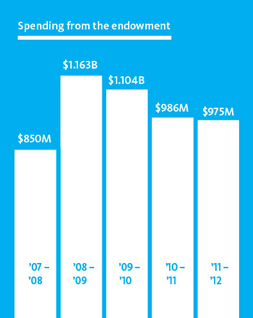 loading
loading
Light & VerityAs budget cuts continue, faculty jobs go unfilled Mark Zurolo ’01MFA. Source: Yale financial reports.The money available from Yale's endowment is in its third year of decline because of Yale's "smoothing rule." View full image
History and classics professor John Matthews was one of four professors teaching Roman history at Yale when he arrived from Oxford in 1996. Now he's the only one. Matthews is ready to retire, but he can't be sure he'll be replaced. "If I were to retire and they were not to make a junior replacement, there would be no full-time ladder faculty doing Roman history," he says. "It really is a bind." As Yale continues to feel the effects of a $6.5 billion loss in the value of its endowment in 2008–09, the administration announced in January that there would be additional cuts in the university's $2.5 billion budget for 2011–12, to try to close a $68 million deficit. Although non-academic units have absorbed 72 percent of the reductions made in the last two years, administrators are increasingly making cuts in academic departments and schools. One way they're doing that is by delaying searches to replace departing faculty members. So when a faculty member retires or leaves Yale, it is no longer a given that the provost's office will authorize the hiring of a replacement. Twenty-three searches were authorized this year, but many other positions are going unfilled for now. Paul Freedman, acting chair of the history department, says that his department has seven current or upcoming vacancies but is conducting only four searches. "I wouldn't say that we are yet feeling adverse effects," says Freedman. The slowdown in faculty hiring comes after a decade in which the number of Yale's "ladder faculty"—tenured professors and full-time junior faculty aspiring to tenure—grew from about 600 (in 2000) to about 700 (in 2010). "The FAS faculty was growing at about two percent a year, after a period in which we hadn't grown two percent for 30 years," says President Richard Levin '74PhD. "The faculty got used to growing, when in fact the norm for Yale over the long haul has been a stable student body and a stable faculty." Nonetheless, Levin acknowledges that "some departments have been caught in a moment where they anticipated either replacing someone or growing, and they're disappointed that they can't proceed." The endowment has made modest gains in the past two years, but Yale has had less endowment income to spend each year because of its "smoothing rule." Basically, the university tries to spend 5.25 percent of the value of the endowment, taken over a five-year rolling average; as a result, the effects of the 2008 drop are spread out over five years. In their January statement on the budget, Levin and Provost Peter Salovey '86PhD say they expect endowment income to be flat for the next three years. Besides looking for cost reductions in academic departments, the administration is asking nonacademic units to make cuts averaging 5 percent. John Matthews, for his part, got an offer he couldn't refuse: Yale recently launched a retirement incentive in which faculty get a year of full pay for half-time teaching before retiring. "So I'll be doing one year at half time next year and just hoping that they'll make a replacement," he says.
The comment period has expired.
|
|